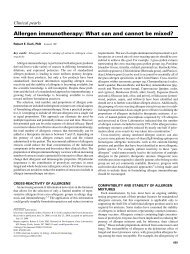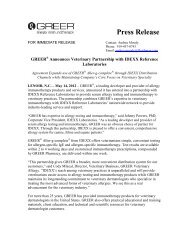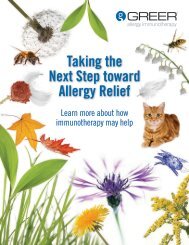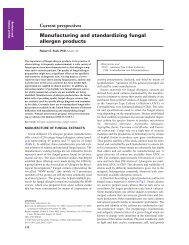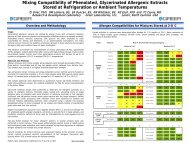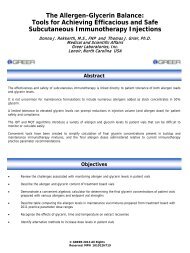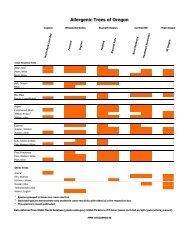Human Allergy Catalog - Greer
Human Allergy Catalog - Greer
Human Allergy Catalog - Greer
Create successful ePaper yourself
Turn your PDF publications into a flip-book with our unique Google optimized e-Paper software.
DOSAGE AND ADMINISTRATIONTECHNIQUESThe most frequently used test sites are the back and the volar surface of theforearms. The skin should be cleansed with alcohol and allowed to dry. Aminimum of at least 1 inch should be allowed between test sites, and preferably2 inches between sites for pollens. A marking pencil may be used to indicatethe site locations.A sterile puncture device, needle, scalpel blade, or scarifier is used. A separatesterile device must be used for each patient to prevent transmission of infectiousagents. If the device contacts extracts, use a separate device for each antigen toprevent cross-contamination.The skin is abraded only enough to enter the dermis without drawing blood.Follow the directions for the device being used. The antigen may be applieddirectly with a puncture device or is introduced by applying a drop of extract tothe scratch or prick site, taking care not to touch the skin with the dropper tip.The number of tests that can be performed at one sitting depends upon thesensitivity of the patient and other clinical aspects. Normally, 30 to 40 testsadministered at one time should be sufficient. For patients of extreme sensitivity,it is advisable to limit the number of tests to not more than 10, and use theforearm only so that a tourniquet can be applied in the event of a severe reaction.For the patient with a suspected diagnosis of allergy to more than one antigen,initial skin testing should include the individual extracts. If a screening skin testwith a mixture is used, a positive response should be followed by testing with theindividual extracts to determine the degree of sensitivity to each. However,because a negative skin test with a mixture may not be indicative of the absenceof allergy to one or more of the components due to their dilution, testingwith individual extracts is more precise. False negative responses may occur ifserum levels of antihistamines remain from prior medication administration(See DRUG INTERACTIONS). The use of a positive control is especiallyrecommended for patients on prior medications which may decrease thehistamine skin test response.Initial testing may be conducted with the concentrate by means of a puncture testemploying a multiple puncture device or other appropriate instrument. Pricktesting through a drop of extract or scratch testing with a drop of extract appliedto the scratch may also be employed to determine the degree of sensitivity. If alarge whealing reaction occurs prior to the 20-minute period, wipe the area freeof extract with an alcohol sponge. After final readings, all antigens should beremoved by gently wiping with an alcohol sponge or sterile cotton swab. If theresponse is negative, this initial test may be followed by intradermal testing whichshould be correlated with the clinical history.1. Scratch or Prick-puncture Skin Testing:Scratch and Prick-puncture testing normally is performed with 1:20w/v extracts in 50% glycerin or the strongest available strength in 5 mL vialsfor diagnostic use. Prick-puncture tests with concentrated extracts in5



